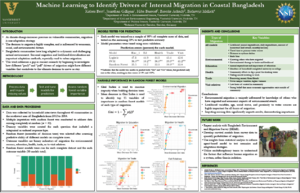2018 CSDMS meeting-062: Difference between revisions
No edit summary |
No edit summary |
||
| Line 64: | Line 64: | ||
{{CSDMS meeting abstract template 2018 | {{CSDMS meeting abstract template 2018 | ||
|CSDMS meeting abstract=As climate change and environmental variability increase pressure on vulnerable communities, migration is one possible adaptation strategy. However, the decision to migrate is complex, and environmental factors are rarely the sole drivers of that decision. Rather, the decision to migrate is often influenced by a combination of economic, social, political, and environmental pressures. This is especially true in coastal communities in Bangladesh, where temporary migration has long been a method of livelihood diversification, and researchers are trying to understand how environmental factors influence existing migration flows. This work addresses a gap in current research by beginning to investigate how different “push” and “pull” drivers of migration might have distinctive variables that contribute to the ultimate decision to move or stay. In this study, random forest classification models are applied to a dataset consisting of household surveys from more than 1,200 households in southwestern Bangladesh to directly assess key variables that influence five types of migration in coastal communities: temporary migration within a village due to environmental stress, migration for education, migration for healthcare, migration for trade or commerce, and migration to visit relatives. This work demonstrates that these types of migration do have different drivers, which yields insights into the complex motivations that impact the decision to migrate. However, livelihood variables and individual aspirations were key for all investigated forms of migration. In the process, this work demonstrates that random forest models could be a powerful method for improving predictive accuracy of migration models to better inform migration policy and planning. | |CSDMS meeting abstract=As climate change and environmental variability increase pressure on vulnerable communities, migration is one possible adaptation strategy. However, the decision to migrate is complex, and environmental factors are rarely the sole drivers of that decision. Rather, the decision to migrate is often influenced by a combination of economic, social, political, and environmental pressures. This is especially true in coastal communities in Bangladesh, where temporary migration has long been a method of livelihood diversification, and researchers are trying to understand how environmental factors influence existing migration flows. This work addresses a gap in current research by beginning to investigate how different “push” and “pull” drivers of migration might have distinctive variables that contribute to the ultimate decision to move or stay. In this study, random forest classification models are applied to a dataset consisting of household surveys from more than 1,200 households in southwestern Bangladesh to directly assess key variables that influence five types of migration in coastal communities: temporary migration within a village due to environmental stress, migration for education, migration for healthcare, migration for trade or commerce, and migration to visit relatives. This work demonstrates that these types of migration do have different drivers, which yields insights into the complex motivations that impact the decision to migrate. However, livelihood variables and individual aspirations were key for all investigated forms of migration. In the process, this work demonstrates that random forest models could be a powerful method for improving predictive accuracy of migration models to better inform migration policy and planning. | ||
|CSDMS meeting posterPDF=Best2_CSDMS_POSTER_May2018.pdf | |||
|CSDMS meeting posterPNG=Best2_CSDMS_POSTER_May2018.png | |||
}} | }} | ||
{{blank line template}} | {{blank line template}} | ||
Latest revision as of 07:13, 18 May 2018
Log in (or create account for non-CSDMS members)
Forgot username? Search or email:CSDMSweb@colorado.edu
Browse abstracts
Machine Learning to Identify Drivers of Internal Migration in Coastal Bangladesh

As climate change and environmental variability increase pressure on vulnerable communities, migration is one possible adaptation strategy. However, the decision to migrate is complex, and environmental factors are rarely the sole drivers of that decision. Rather, the decision to migrate is often influenced by a combination of economic, social, political, and environmental pressures. This is especially true in coastal communities in Bangladesh, where temporary migration has long been a method of livelihood diversification, and researchers are trying to understand how environmental factors influence existing migration flows. This work addresses a gap in current research by beginning to investigate how different “push” and “pull” drivers of migration might have distinctive variables that contribute to the ultimate decision to move or stay. In this study, random forest classification models are applied to a dataset consisting of household surveys from more than 1,200 households in southwestern Bangladesh to directly assess key variables that influence five types of migration in coastal communities: temporary migration within a village due to environmental stress, migration for education, migration for healthcare, migration for trade or commerce, and migration to visit relatives. This work demonstrates that these types of migration do have different drivers, which yields insights into the complex motivations that impact the decision to migrate. However, livelihood variables and individual aspirations were key for all investigated forms of migration. In the process, this work demonstrates that random forest models could be a powerful method for improving predictive accuracy of migration models to better inform migration policy and planning.
